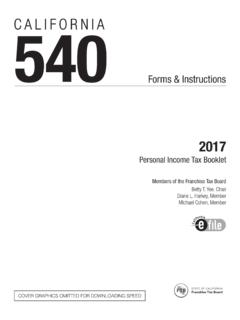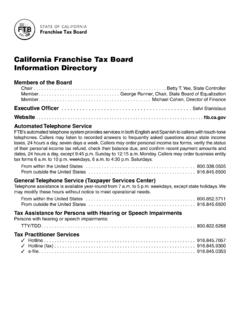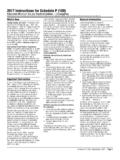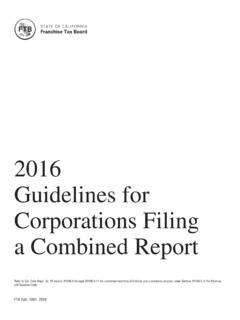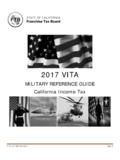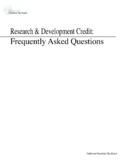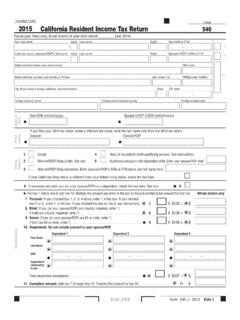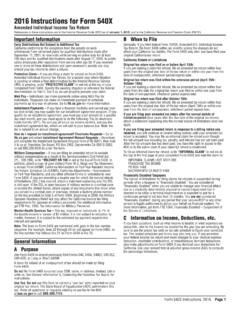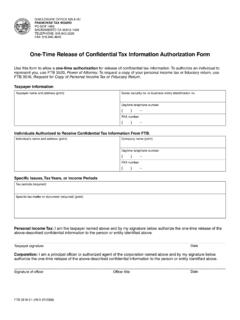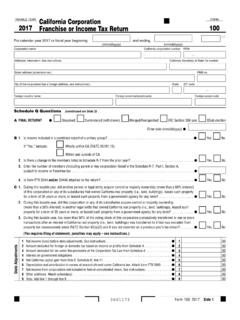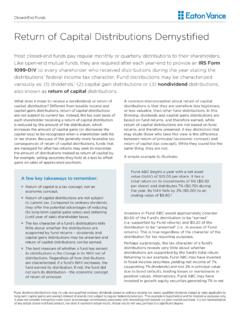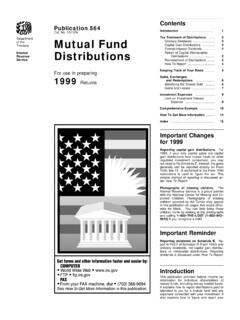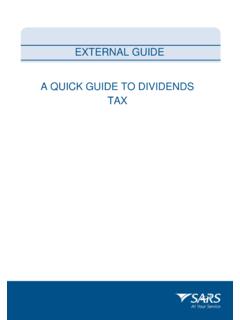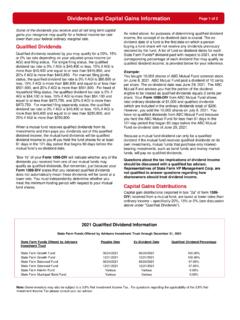Transcription of Chapter 7 Earnings & Profits and Distributions
1 Chapter 7 Earnings & Profits and Distributions Contents: a. Introduction b. E&P to be Determined on a Separate Company Basis c. Calculation of E&P for Federal Tax Purposes d. Calculation of E&P for California Tax Purposes e. Special Items to Consider in Computing E&P f. E&P of Foreign Corporations g. Internal Revenue Code (IRC) 482 Adjustments h. Impact of distribution on E&P i. Characterization of distribution Received j. Determining California Tax Treatment of Dividends Source of Distributions k. dividend Received from Foreign Corporations Partially Included in a Water's-Edge Combined Report l. Dividends Paid from E&P Attributable to Excluded Income m. Maintenance of Books and Records n. Audit Tips o. Summary a. Introduction Congress has never provided a statutory definition of Earnings and Profits (E&P). Instead, a definition has developed over the years from a collection of administrative practices, court cases, revenue rulings, and adjustments required under IRC 312.
2 In Henry C. Beck Co. v. Commissioner, (52 TC 1, (1969)), E&P was defined as an attempt to "approximate a corporation's power to make Distributions which are more than just a return of investment." A correct computation of E&P for federal and California tax purposes is necessary to determine the tax treatment of corporate Distributions ( , dividend , return of capital, or capital gain). California generally incorporates, "except as otherwise provided," the provisions of the IRC 301-385, which relate to corporate Distributions and adjustments. ( Revenue and Taxation Code (R&TC) 24451.) IRC 316 provides the definition of a dividend . IRC 316(a) states that any distribution of property is a dividend if paid from: Earnings and Profits of the taxable year, or Earnings and Profits accumulated since February 13, 1913 IRC 316(a) also provides for a last-in, first-out (LIFO) ordering rule. It states that "Except as otherwise provided in this subtitle, every distribution is made out of Earnings and Profits to the extent thereof, and from the most recently accumulated Earnings and Profits .
3 " California follows this E&P ordering rule for dividend payments, where dividends are deemed to be paid out of current E&P first, and then layered back on a LIFO basis. For Federal purposes the importance of E&P in the international area can be demonstrated by the effect it has on items such as: Subpart F Income taxable as a deemed dividend to the extent of the shareholder's pro-rata share of its current E&P. (IRC 951.) Indirect Foreign Tax Credits E&P is a significant factor used to compute the deemed paid credit under IRC 902 and 960. For California purposes, the importance of E&P can be demonstrated by the effect it has on the following: dividend income includible in the water's-edge combined report. dividend elimination and deductions E&P is necessary to determine the correct amount of dividend elimination and dividend -received deductions allowed under R&TC 25106, 24410, and 24411.
4 Controlled Foreign Corporations (CFCs) Current E&P is required to compute the inclusion ratio, which is used to determine the income and apportionment factors includible in a water's-edge combined report for unitary CFCs with Subpart F income pursuant to R&TC 25110(a)(2)(A)(ii). Foreign Investment Interest Offset E&P is included in the computation of the unassigned foreign investment and total assets, which are components of the formula used to determine the interest expense that is attributable to foreign investments. (CCR 24344(c).) In general, computing the E&P of a corporation included in the waters-edge combined report begins with net income after state adjustments (Form 100W, page 1, line 18) and by making a series of positive and negative adjustments. For the most part, by incorporation of IRC 316, California follows the federal adjustments to arrive at Earnings and Profits : Add nontaxable income ( , Intercompany dividends) Add artificially created deductions ( , dividend received deductions) Subtract nondeductible expenses ( , federal income tax) Generally, E&P for federal tax purposes will be similar to E&P for California tax purposes.
5 However, E&P for federal and California may differ due to differences in elections and methods adopted in computing the respective taxable income ( , difference in basis caused by different elections under IRC 338 (sale of stock treated as asset sale), or IRC 1031 (like-kind exchanges)). For further discussion on differences between federal and California E&P calculations, see section d, of this Chapter . b. E&P to Be Determined on a Separate Company Basis Under California law, for purposes of determining the amount of E&P of a corporation, unitary attributes of a corporation are disregarded. Income apportioned to a member of a unitary group by formula cannot form the basis for determining that corporation's E&P. For California tax purposes, E&P is determined on a separate company basis. (Appeal of Young's Market Company, 86-SBE-199, November 19, 1986.) The State Board of Equalization's decision in Young's Market Company was upheld by the California Court of Appeals.
6 However, the Court of Appeals decision is not citable because it is an unpublished decision. The Board of Equalization decision is citable. For federal income tax purposes, every corporation has its own E&P account. For corporations, other than a group of corporations electing to file a federal consolidated return, E&P of a subsidiary does not become E&P of its parent prior to a payment of those Earnings to the parent. However, a corporation that is a member of a consolidated group, must adjust its basis in stock of a subsidiary to account for increases and decreases in the E&P of the subsidiary. (Treasury Regulation (Treas. Reg.) ) Treas. Reg. requires "tiering adjustments" whereby the E&P of an upper tier corporation includes the E&P of lower tier subsidiaries. As California does not conform to this regulation, any "tiering adjustments" ( , E&P of lower tier subsidiaries) should be excluded in computing E&P for California tax purposes.
7 Remember, E&P is computed on a separate company basis using separate accounting and arms-length prices (as discussed in WEM 7, section g) for all intercompany transactions. c. Calculation of E&P for Federal Tax Purposes The primary function of E&P is to provide a measure of the economic income of a corporation available for distribution to its shareholders. E&P is not the same as surplus or taxable income, but it shares characteristics of both. E&P for book income purposes ( , retained Earnings ) rarely equals E&P for tax purposes because of different treatments with respect to reserves, depreciation, and depletion. E&P for tax purposes also rarely equals taxable income because of non-cash deductions ( , dividend received deductions) and exclusion of specific items of income ( , federal income tax refund) that are allowed in computing taxable income. Current E&P represents the current economic income computed on an annual basis.
8 Accumulated E&P represents the sum of each year's current E&P reduced by Distributions . 1. Calculation of E&P Current E&P begins with taxable income. (Revenue Procedure 75-17.) For California purposes, start with net income after state adjustments, determined on a separate company basis (s ee WEM 7, section d). Adjustments, both positive and negative, are then made to taxable income. As E&P represents the corporation's economic income, many adjustments are necessary to arrive at the corporation's E&P. The computation of E&P can be summarized as follows: Current year's taxable income/loss + Exempt and nondeferred income + Deductions not permitted in computing E&P - Items not deductible in computing taxable income = Current E&P The following illustrates the common adjustments made to compute current E&P. It lists items that increase or decrease E&P, but it is not intended to be all inclusive. Computation of Current E&P: Taxable Income or Loss, as Corrected PLUS: Exempt and nondeferred income, income per books not on return o Tax exempt interest o Proceeds of officer's life insurance policy o Increase in cash surrender value life insurance policy o Nontaxable portion bad debt recoveries o Refund or prior year federal income taxes (cash basis) o Gains from dealing in taxpayer's own stock (IRC 1032) o Miscellaneous nontaxable income PLUS: Deductions not permitted in computing E&P, noncash deductions, items previously charged to E&P, deductions allowed solely for tax purposes o Dividends elimination and dividend received deduction (R&TC 25106, 24410, 24402, 24411) o Excess of percentage of depletion over cost depletion (caution.)
9 Do not duplicate at time of sale) o Net operating loss (NOL) deduction o Capital loss carryforwards o Cancellation of interest owing by accrual basis corporations previously deducted no tax benefit due to IRC 111 o Charitable contribution carryforwards o Excess depreciation over straight line LESS: Items (expenses and losses) not deductible for tax and items of income accelerated for tax, but not E&P o Officer's life insurance premiums o Amortizable bond premiums on tax exempt bonds o Fines and penalties o Political contributions o Charitable contributions over limitation amount o Excess capital losses o Expenses disallowed in audit not of capital nature ( , excess compensation) o IRC 267 losses and expenses o Current federal income taxes o State and foreign income taxes o IRC 78 gross-up and subpart F income EQUALS: Current Earnings and Profits 2. Additional Adjustments to E&P, IRC 312(n) Additional adjustments are required in computing E&P to accurately reflect economic gain and loss.
10 IRC 312(n) lists specific adjustments to be made in computing E&P: o Construction period interest o Intangible drilling costs and mineral exploration and development costs o Amortization of Circulation (IRC 173) and Organizational (IRC 248) Costs o LIFO inventory adjustments o Installment sales o Completed contract method o Certain stock redemptions o Special rules for certain foreign corporations that report less than 20 percent source income (See WEM 7 , section f) 3. Accounting Methods In computing E&P, the method of accounting adopted in computing taxable income must be the same method used to compute E&P. For example, a taxpayer filing its tax return on an accrual basis must determine its E&P on an accrual basis. (Treas. Reg. (a).) There are exceptions to this rule. For example, the Accelerated Cost Recovery System in computing depreciation (IRC 312(k)) and the installment method (IRC 312(n)(5)) are not allowed in computing E&P.
